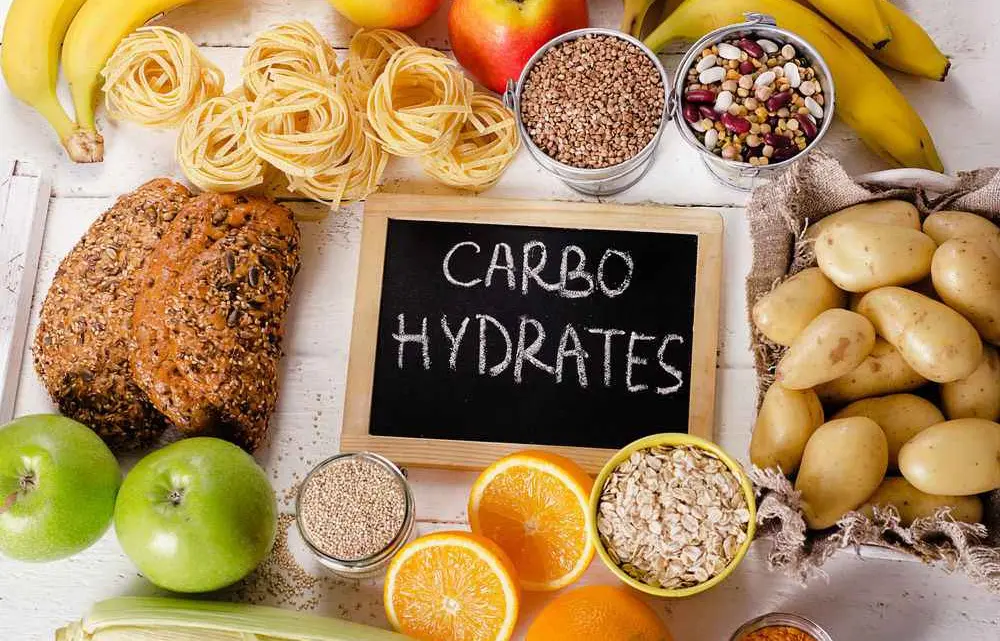Use our carb cycling calculator to accelerate weight/fat loss and reach your goals faster:
How To Use The Carb Cycling Calculator
Here’s a step-by-step for using the carb cycling calculator…
- Choose your gender
- Type in your age, weight, and height
- Select your activity factor from the dropdown (Choosing BMR implies you’re mostly sedentary)
- Choose whether or not you’re sensitive to carbs
- Choose your fat loss goal
You’ll then get your results, which include your basal metabolic rate (calories burned at rest) and a carb cycling routine with recommended calories and macronutrients that you can use, which is based on the 7-day week.
And that’s pretty much it. You have the knowledge and now the tools to hopefully benefit from a carb cycling regime and feel free to adjust as needed according to your progress and goals.
The Role of Carbohydrates
To boost performance and achieve an aesthetically appealing physique, you must consume carbohydrates in a balanced ratio with the other two macronutrients (proteins and fats). Carbs are the body’s primary energy source, providing roughly 4 calories per gram.
Quality carbs are an essential part of a balanced diet. They’re also often the first thing people adjust when aiming for weight loss, improved performance, or better overall health. It leaves you no other option but to understand how carbs impact your physique, functionality, and well-being.
Level Up Your Fitness: Join our 💪 strong community in Fitness Volt Newsletter. Get daily inspiration, expert-backed workouts, nutrition tips, the latest in strength sports, and the support you need to reach your goals. Subscribe for free!
In this article, we’ll explore carb cycling, a strategy that involves alternating your carbohydrate intake daily, weekly, and monthly to lose weight. As a veteran personal trainer, I have experienced wide success implementing carb cycling into my clients’ fitness regimes. Given below is everything you need to know to replicate the results.
What is Carb Cycling?
Carb cycling involves cycling between high, low, moderate, and no-carb days to shock your body and break through weight loss plateaus.
You must align high-volume workouts with high-carb days to ensure optimal glycogen stores for maximal performance. Conversely, you can save the low-carb periods for recovery days.
Manipulating your carbohydrate intake provides the body with adequate fuel for certain activities, but it also minimizes carb intake when the body doesn’t need as much of it.
It’s common to cycle on a daily, weekly, or even monthly basis depending on the goal. [1]
Here are a few reasons why one may choose to carb cycle:
- Limit fat gain: Carbs provide energy, but excess carbs get stored as fat. That’s why you must adjust your carb intake based on activity levels — more carbs on workout days, fewer on rest days.
- Fat loss: Your daily calorie intake dictates whether you will lose or gain weight. Most people cut their calorie intake to enter a deficit by limiting carbs. That’s because carbs are usually the biggest calorie contributors in their diets.
- Improved physical performance: The longer and more intense a physical activity, the more carbohydrates will be needed to fuel the session.
- Competition and special occasions: Athletes competing in a particular weight class carb load after the weigh-ins to fill out the muscles and gain a competitive advantage.
- Overall health: Carbohydrates can significantly affect blood sugar and insulin levels. Insulin is the hormone that helps the body to transport glucose to the cells.
Fat intake is often adjusted alongside carbohydrates while carb cycling to maintain energy levels, as both macronutrients fuel the body. Fat also plays crucial roles in other bodily functions. However, fat is the most calorie-dense macronutrient (about 9 calories per gram).
Protein is usually kept moderate to high as it’s the macronutrient that builds muscle tissue which is needed in sufficient amounts even in an energy deficit where the goal is losing weight/cutting.
Carb Cycling Benefits
Carbohydrates are crucial for numerous bodily functions. Plus, strategically alternating between low and moderate or high carb intake can offer significant benefits.
Hunger
Carb cycling can contribute to hunger hormone (ghrelin and leptin) regulation, therefore, contributing to more weight loss. And research shows that a high-protein and high-fat meal has a more favorable postprandial satiety and appetite hormonal response when compared to a high-carb meal. [2, 3, 4, 5]
“Some people find that having higher calorie days helps them stick to their diet in the long term,” said Dr. Layne Norton (Ph.D. in Nutritional Sciences).
You can also strategically use high-carb days to quench cravings.
“I position my high-carb days on the weekends because weekends are typically correlated with more social events and eating out with friends,” said Brian DeCosta, WNBF Natural Bodybuilding World Champ. “This way, I have more carbs to play with on the days I am more likely to eat out.”
Get Fitter, FasterLevel Up Your Fitness: Join our 💪 strong community in Fitness Volt Newsletter. Get daily inspiration, expert-backed workouts, nutrition tips, the latest in strength sports, and the support you need to reach your goals. Subscribe for free!
Glycogen replenishment and insulin health
Glucose is crucial for replenishing your body’s energy stores (glycogen). Protein enhances this process by boosting insulin secretion. That’s why consuming more carbs on active days supports your workouts and recovery. [6]
However, speaking of insulin, one study found that just a modest reduction in carbs has positive effects on glucose metabolism, in addition to fat distribution and body composition. [7]
This is valuable information for overweight individuals and those with type 2 diabetes. Remember, drastic dieting can be harmful. Always consult a medical professional before making significant dietary changes, especially if you have any existing health conditions.
Burn more fat
Another benefit of carb cycling is that low-carb, moderate to high-fat days allow the body to burn fat more efficiently as it becomes the more prominent energy source. This is otherwise known as ketosis, where the body produces ketones, often called ‘super fuel‘. [8]
However, this is typically achieved when daily carb intake is 50 grams or less.
Now, we could all agree that the average American’s diet is carb-heavy with all of the delectable goodies. Cutting out carbs can also drastically reduce overall calories consumed, which can help people lose weight. However, this applies to any of the macronutrients as well. [9]
It’s also important to note that the hormone insulin stores fat in the body, but a low-carb diet can actually lower insulin levels, allowing the body to utilize these fat stores more easily.
This is also why you tend to lose water on a low-carb diet because it causes your kidneys to release excess water. [10, 11]
Performance
Carbs are crucial for fueling high-intensity workouts and short-duration sprints. In a scientific review, subjects who consumed carbohydrates demonstrated improved performance during these activities. [12]
In fact, while protein and fats can be viable energy sources in some instances, carbs are the only macronutrients that can be broken down quickly enough to sustain maximal performance during high-intensity activities, according to one 2018 scientific review. [13]
Another benefit of manipulating carb intake is improved cholesterol (raises HDL and improves LDL), and research shows that low-carb diets are as effective as low-fat diets for weight loss and metabolic risk factors. [14, 15]
“Athletes can train in a fasted or low-carbohydrate state to improve mitochondrial biogenesis, capillary density, and ketone utilization. This adaptation is beneficial for endurance athletes,” said Dr. Peter Attia (MD).
Sample Carb Cycling Routine
There’s no one-size-fits-all formula for diet and nutrition, and carb cycling is no exception.
However, the best way to implement carb cycling depends on your goals. Here’s a sample weekly routine:
- Day 1: Weight training (high carb, low fat)
- Day 2: Active recovery/ cardio (moderate carb, moderate fat)
- Day 3: Weight training (high carb, low fat)
- Day 4: Weight training (high carb, low fat)
- Day 5: Rest (low carb, high fat)
- Day 6: Weight training (high carb, low fat)
- Day 7: Rest (low carb, high fat)
Of course, you can tweak this based on your schedule. But you can also do high or low carb for as long as you want and then switch it up once in a while based on how you feel, your lifestyle, and your progress.
Low-carb days (not keto) typically consist of anywhere from 50 to 50 grams of carbs, whereas higher-carb days can consist of anywhere from 130 to over 400 grams per day. But again, there are several factors that will determine an appropriate daily carb intake.
Good Carb Sources To Eat
High carb days and most of your carb consumption should consist of healthy, nutritious food sources that provide quality, complex (slow-digesting) carbs and a few fast-digesting carbs like some fruits. Good carbs provide lasting energy, necessary vitamins and minerals, and fiber to support digestion and bowel health.

But if you’re not sure which foods are best for your goals then here’s a list of quality options…
- Vegetables (leafy greens, cauliflower, carrots)
- Tubers (sweet potatoes, potatoes)
- Grains (oats, rice, quinoa)
- Fruits (berries, bananas, apples, kiwis)
- Legumes (chickpeas, lentils, black beans)
There are, of course, more options, but these foods are nutritious and healthy for most fitness goals. Low-carb days should consist of more non-starchy carbs such as greens, onions, and tomatoes, while high-carb days can consist of starchy carbs like potatoes, legumes, corn, etc.
Other similar Calculators
- TDEE Calculator
- Intermittent Fasting Calculator
- Water Fasting Weight Loss Calculator
- Weight Gain Calculator
- Macro Calculator
- Body Fat Calculator
Frequently Asked Questions
What is carb cycling?
It involves manipulating your carb intake in an alternating fashion to achieve a specific outcome.
For example, if your goal is weight loss, you’ll want to alternate high and low-carb days to optimally benefit you from the weight loss effects of low-carb dieting while also supplying the body with sufficient carbs on more active days.
What's the best way to carb cycle?
There are many different ways to cycle carbs, but no single formula will work for everyone. However, you can follow a basic, weekly carb cycling routine for a few weeks and see how it works for you. This way, you can make any necessary adjustments based on how you feel, your goals, and how your body responds.
This is where the carb cycling calculator comes in handy. It does most of the work for you and gives you a plan to follow.
What are the benefits of carb cycling?
Carb cycling can help minimize fat gain, promote fat loss, enhance metabolic health, improve insulin sensitivity and cholesterol levels, and boost physical performance.
Can carb cycling cause side effects?
Changes in carbohydrate intake can result in feelings of dizziness, headache, trouble sleeping, mood changes, irritability, lack of energy, constipation, etc.
However, this can vary for each individual. For most people, these side effects tend to subside after a week or so once a routine is established and overall nutrition is sufficient to support healthy functioning.
References:
- Coyle EF. Timing and method of increased carbohydrate intake to cope with heavy training, competition and recovery. J Sports Sci. 1991 Summer;9 Spec No:29-51; discussion 51-2. doi: 10.1080/02640419108729865. PMID: 1895362.
- Poehlman ET, Tremblay A, Fontaine E, Després JP, Nadeau A, Dussault J, Bouchard C. Genotype dependency of the thermic effect of a meal and associated hormonal changes following short-term overfeeding. Metabolism. 1986 Jan;35(1):30-6. doi: 10.1016/0026-0495(86)90092-2. PMID: 3510362.
- Dirlewanger M, di Vetta V, Guenat E, Battilana P, Seematter G, Schneiter P, Jéquier E, Tappy L. Effects of short-term carbohydrate or fat overfeeding on energy expenditure and plasma leptin concentrations in healthy female subjects. Int J Obes Relat Metab Disord. 2000 Nov;24(11):1413-8. doi: 10.1038/sj.ijo.0801395. PMID: 11126336.
- Hu T, Yao L, Reynolds K, Niu T, Li S, Whelton P, He J, Bazzano L. The effects of a low-carbohydrate diet on appetite: A randomized controlled trial. Nutr Metab Cardiovasc Dis. 2016 Jun;26(6):476-88. doi: 10.1016/j.numecd.2015.11.011. Epub 2015 Dec 12. PMID: 26803589; PMCID: PMC4873405.
- Parvaresh Rizi E, Loh TP, Baig S, Chhay V, Huang S, Caleb Quek J, Tai ES, Toh SA, Khoo CM. A high carbohydrate, but not fat or protein meal attenuates postprandial ghrelin, PYY and GLP-1 responses in Chinese men. PLoS One. 2018 Jan 31;13(1):e0191609. doi: 10.1371/journal.pone.0191609. PMID: 29385178; PMCID: PMC5792004.
- Ivy JL. Glycogen resynthesis after exercise: effect of carbohydrate intake. Int J Sports Med. 1998 Jun;19 Suppl 2:S142-5. doi: 10.1055/s-2007-971981. PMID: 9694422.
- Gower BA, Goss AM. A lower-carbohydrate, higher-fat diet reduces abdominal and intermuscular fat and increases insulin sensitivity in adults at risk of type 2 diabetes. J Nutr. 2015 Jan;145(1):177S-83S. doi: 10.3945/jn.114.195065. Epub 2014 Dec 3. PMID: 25527677; PMCID: PMC4264021.
- Volek JS, Noakes T, Phinney SD. Rethinking fat as a fuel for endurance exercise. Eur J Sport Sci. 2015;15(1):13-20. doi: 10.1080/17461391.2014.959564. Epub 2014 Oct 2. PMID: 25275931.
- Sacks FM, Bray GA, Carey VJ, Smith SR, Ryan DH, Anton SD, McManus K, Champagne CM, Bishop LM, Laranjo N, Leboff MS, Rood JC, de Jonge L, Greenway FL, Loria CM, Obarzanek E, Williamson DA. Comparison of weight-loss diets with different compositions of fat, protein, and carbohydrates. N Engl J Med. 2009 Feb 26;360(9):859-73. doi: 10.1056/NEJMoa0804748. PMID: 19246357; PMCID: PMC2763382.
- Velasquez-Mieyer PA, Cowan PA, Arheart KL, Buffington CK, Spencer KA, Connelly BE, Cowan GW, Lustig RH. Suppression of insulin secretion is associated with weight loss and altered macronutrient intake and preference in a subset of obese adults. Int J Obes Relat Metab Disord. 2003 Feb;27(2):219-26. doi: 10.1038/sj.ijo.802227. PMID: 12587002; PMCID: PMC1490021.
- Tiwari S, Riazi S, Ecelbarger CA. Insulin’s impact on renal sodium transport and blood pressure in health, obesity, and diabetes. Am J Physiol Renal Physiol. 2007 Oct;293(4):F974-84. doi: 10.1152/ajprenal.00149.2007. Epub 2007 Aug 8. PMID: 17686957.
- Pizza FX, Flynn MG, Duscha BD, Holden J, Kubitz ER. A carbohydrate loading regimen improves high intensity, short duration exercise performance. Int J Sport Nutr. 1995 Jun;5(2):110-6. doi: 10.1123/ijsn.5.2.110. PMID: 7670450.
- Kanter M. High-Quality Carbohydrates and Physical Performance: Expert Panel Report. Nutr Today. 2018 Jan;53(1):35-39. doi: 10.1097/NT.0000000000000238. Epub 2017 Oct 21. PMID: 29449746; PMCID: PMC5794245.
- Volek JS, Sharman MJ, Gómez AL, Scheett TP, Kraemer WJ. An isoenergetic very low carbohydrate diet improves serum HDL cholesterol and triacylglycerol concentrations, the total cholesterol to HDL cholesterol ratio and postprandial pipemic responses compared with a low fat diet in normal weight, normolipidemic women. J Nutr. 2003 Sep;133(9):2756-61. doi: 10.1093/jn/133.9.2756. PMID: 12949361.
- Volek JS, Phinney SD, Forsythe CE, Quann EE, Wood RJ, Puglisi MJ, Kraemer WJ, Bibus DM, Fernandez ML, Feinman RD. Carbohydrate restriction has a more favorable impact on the metabolic syndrome than a low fat diet. Lipids. 2009 Apr;44(4):297-309. doi: 10.1007/s11745-008-3274-2. Epub 2008 Dec 12. PMID: 19082851.










With this calculator, I’m assuming the macros and calories listed already take into consideration calories burned, so, I can unlink my smart watch from calorie/macro tracker?
Great article.
Yes 🙂 based on your “Activity Factor” our calculator calculate the macros.
Team F.V.
Hi Dear admin
This content is awesome and informative. Step by step discussion makes this content easier to readers. In my opinion, Fruit and veg are low in calories and fat, and high in fiber – 3 essential ingredients for successful weight loss. Foods containing lots of fiber can help keep anyone feeling full, which is perfect for losing weight. One should use the calorie information to work out how a particular food fits into his/her daily calorie allowance on the weight loss plan.
Hi, This is the first time I’ve heard about carb cycling. I get asked about diets all the time in my profession, so like to know what’s out there. I’m just commenting to point out a big typo in case you want to correct it. The error is when the article talks about low carb days consisting of 50-150 grams per pound of body weight…etc. Not sure what it’s supposed to say instead, perhaps it’s just supposed to say 50-150 grams per day?
Hi Jill. Thank you very much for bringing that to our attention, it was definitely a typo and you’re correct, it’s grams per day 🙂
Thank you!
Are the grams given to the right meant to be macros per meal, until you reach the calories?
Hi there, you bet! The numbers on the right are the recommended total grams per day for each macronutrient. Hope that helps 🙂
Is this based on Net Carbs or Total Carbs in the calculation?
Hi there, it would be net carbs because they digest and convert to glucose and as a result affect the carb cycling process.
I teach an intensive spin class (usually burn 600 ish calories) and am wondering if that would be a good day to be moderate carb or high carb? I also teach HIIT a couple days and we do a lot of lifting and Pilates another. I know Pilates would be a good day to be low carb as it uses less energy. I really want to give this a try! I think the protein would be a struggle for me as I’m vegan, so getting in 144 grams will be interesting 🙂
For the calculator are we entering current or desired weight? Thanks!
Your current weight!
can you explain what carb sensitive means? Like gluten sensitive? Or you gain weight easily from eating carbs or?
Hi Delaney,
Thanks for your question! When we refer to being “carb sensitive” in the article, it’s quite different from gluten sensitivity. Carb sensitivity primarily relates to how your body processes and reacts to carbohydrates. For some individuals, consuming carbs can lead to more significant fluctuations in blood sugar levels, which might result in quicker fat storage if these carbs are not used as energy. It’s not solely about gaining weight easily, but more about how your body handles carbs in terms of energy usage and storage. It’s important to understand your body’s response to carbs, as it can guide your dietary choices, especially in the context of carb cycling for weight management or fitness goals.
For a more in-depth understanding, you might find it helpful to revisit the section in the article where we discuss different body types and their responses to carbohydrate intake.
What does sensitive to carbs actually mean?
Hi Wendy,
If you have high carb sensitivity, eating carbs leads to a big spike in blood sugar followed by a crash. This can cause intense cravings for more carbs and sweets, fatigue and energy slumps, difficulty controlling your appetite, and weight gain, especially around the belly.
I hope this helps.